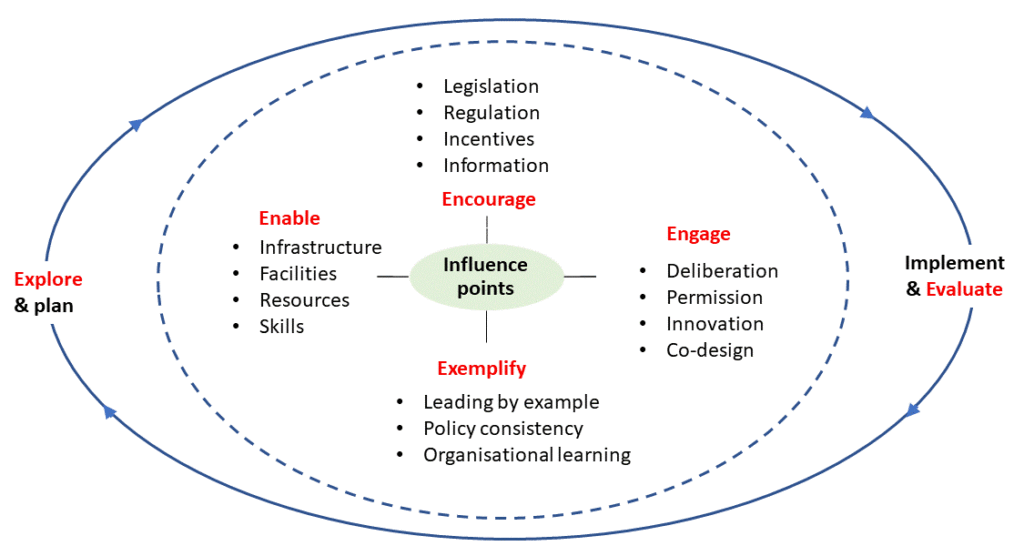Six ways that agencies can influence behaviours

Often agencies and policy makers become reliant on a handful of approaches that they use to influence behaviour. This post introduces the 6 E’s framework as a a framework for agencies wanting to utilise a broader suite of policy approaches to more effectively encourage different groups and sectors to be mobilised, supported and encouraged to participate in the “common enterprise” of generating positive outcomes’. It links policy development with systems thinking and adaptive management.
There is a growing range of complex policy areas, so-called ‘wicked’ problems, where it has become increasingly clear that government cannot simply ‘deliver’ policy outcomes to disengaged and passive sectors and publics. In these areas (e.g. natural resource management, public health, poverty, education, the environment) it is clear that achieving significant progress requires the active involvement and cooperation of a great number of groups and individuals.Yet all too often we approach these issues with linear and even siloed solutions that aren’t sufficient to address the problems at the scale at which they exist. Successful outcomes from addressing these ‘wicked problems’ increasingly depend on the coordinated actions of decision-makers at different levels – from individuals and communities to enterprise and sector organisations, to region and nation (policy agents). This is where concepts such as partnerships and co-design come into play. By sharing information, resources, activities, and capabilities we can achieve things together that we could never achieve alone.
Policy as a co-designed activity
Even where the issue is not necessarily seen as complex, it is often crucial that a range of stakeholders and publics get actively engaged to achieve desired outcomes . This recognition has led to a focus on co-design where the achievement of outcomes is seen as a joint responsibility of the government, key stakeholders and the wider community. While many policy drivers are still evolving from the mass production model (often regulation and legislation) of earlier times, there is growing interest in focusing beyond the internal workings and efficiencies of existing services, and looking more closely at how people engage with those services, and how different groups and sectors can be mobilised, supported and encouraged to participate in the “common enterprise” of generating positive outcomes’.
This growing realisation has led to a shift of interest towards models of ‘co-design’, which recognise that policy makers may often have more impact on key outcomes by using their limited resources to engage, involve and influence the behaviour of users and other parties, rather than concentrating on traditional modes of providing services. Influencing behaviour is not a linear process where policy makers enforce a particular policy with a distinctive and well-defined effect. Policy success depends on many factors and particularly on the cooperation of different groups of society. Accordingly contemporary policy trends are recognising the need to creatively utilise the multiple mechanisms available in designing approaches to promote action on environmental and other complex issues.
The 6 E’s policy design framework
There are a range of policy choice tools that aim to link theory and practice, and in general these encourage policy makers to use a mix of options – taking the context and stakeholder characteristics into account. In this posting I look at DEFRA’s 4Es policy framework (see Figure 1 – centre circle) as one such tool which provides a framework to help policy makers develop a mix of interventions across four broad categories of policy tools – Enable, Engage, Encourage and Exemplify. More recently the UK Behavioural Insights Team through its Mindspace report has added two additional “E”s (see Figure 1 – outside circle) that round out a process of informed policy design and results measurement. Using this tool as a checklist can help agencies to more effectively influence behaviour by combining approaches across these six broad categories.

Collectively, the approach and the mix of measures drawn from across the 4Es need to address the core motivations and barriers of the broader range of stakeholders involved – including agencies themselves. For example, it’s likely including measures that engage and enable will lead to “change” through those most willing and able to act. It’s also feasible that some other groups may act if agencies demonstrate their own willingness to “walk the talk” and model the collaborative behaviours they would like to encourage. For others there is a role for regulation, or the development of minimum or voluntary standards before behaviour is influenced. Each element encompasses a suite of potential approaches and some of these are indicated below.
Enable – We need to start where people are. This makes it easier for people to make the right choice. What is important is that people and sectors are provided with the support they need to make responsible choices (e.g. by putting the right infrastructure and services in place, building skills, removing barriers, training).
Engage – It is important to get people involved. Effective public engagement is necessary to provide legitimacy for interventions that may be introduced. Behaviour change can be controversial, involve difficult tradeoffs, and relate to areas where government legitimacy is controversial. These questions are both tricky and of general concern to the public. This may require new methods of engagement and co-design to explore what actions are socially acceptable or to gain legitimacy for a proposed practice change. In this areas agencies could leverage networks, work with trusted intermediaries and champions, and build a shared understanding through the use of dialogue and learning-based approaches.
Encourage – This covers the broad range of approaches that agencies have to encourage change (e.g. regulation, minimum standards, social marketing). It requires developing and putting in place incentives (in their broader sense) to encourage – and disincentives to discourage – a target audiences response. Providing feedback on progress is also important in this respect. One set of principles for encouraging change can be found in an earlier LfS post – Sustainability: six ways to influence behavior change.
Exemplify – In most behaviour change interventions, exemplifying desired changes is important. This requires those designing change to lead by example and to ensure that the actions of the policy agents are consistent with the change being sought. This puts the onus on agencies and policy partnerships to review their internal policies and take action to ‘exemplify’ the same behaviour they are asking for (e.g. demonstrate the ability to work in a partnership, collaboration, ensuring messages are consistent across agencies).
Policy design and adaptive management
The final two E’s – explore and evaluate – serve to embed the 4 E’s in a broader process of informed policy design and results measurement. This brings in concepts of systems thinking, systemic design, learning, reflective practice and adaptive management and policy. Together, exploring and evaluating create a broad learning environment through which the development and implementation of policy and management can adapt. A related post on this site – After action reviews and how they can be linked with ToCs to support strategic thinking – highlights how the 2 E’s can be used in tandem to create both the space and guidance for strategic learning, and subsequent adaptation and innovation.
Explore – Understanding the issue and the wider context in which it is sited. This needs to include inquiring into how the different stakeholders involved experience things and to understand the behaviour that is being targeted. Broad approaches such as systems thinking and systemic design are particularly useful in this setting encourages us to explore inter-relationships (context and connections), perspectives (each actor has their own unique perception of the situation) and boundaries (agreeing on scope, scale and what might constitute an improvement). Recognising these various influences is crucial, given the complex ways in which people make decisions.
Evaluate – If we are to improve the way we look to influence positive change then we need to understand the complex range of factors that affect stakeholder behaviour, and good evaluation provides a way of doing so. Although there will always be a healthy tension between evidence-based policy and innovation-based policy, the wider aim should be evidence-based innovation. Building the capacity to reflect on action so as to engage in a process of continuous learning is increasingly seen as an important aspect of behavior change, and it is beginning to be used in many models of changing professional practice. However, it is not a conscious behavior for many teams, and effort needs to be put in to provide teams with tools that can support reflection. These tools are usually known under names such as After Action Review (AAR) or Learning Debriefs, and are used by to capture the lessons learned from past successes and failures, with the goal of improving future performance.
The complexity and uncertainty of challenges such as welfare, health, crime, employment, education and the environment demand that our systems of governance and our policies be adaptive. Policy responses in these areas should be designed to both reflect local contexts and adapt as conditions change. In fact, instead of helping, governance and policy that are not adaptive could actually hinder the ability of households, communities and businesses to cope with and adapt to change. Frameworks such as the 6 E’s can be seen as a communication tool for the co-design of policies that offer a way to actively engage a range of stakeholders to find solutions for complex water management issues.
An independent systems scientist, action research practitioner and evaluator, with 30 years of experience in sustainable development and natural resource management. He is particularly interested in the development of planning, monitoring and evaluation tools that are outcome focused, and contribute towards efforts that foster social learning, sustainable development and adaptive management.

0 Comments on “Six ways that agencies can influence behaviours”